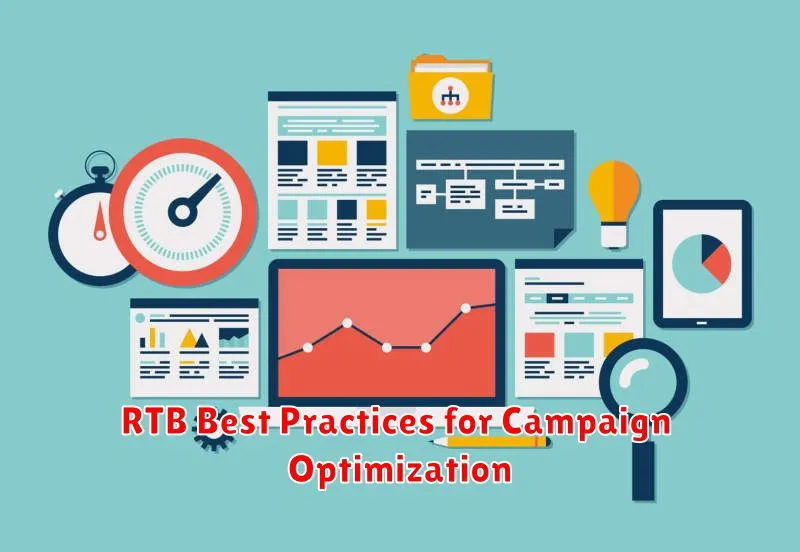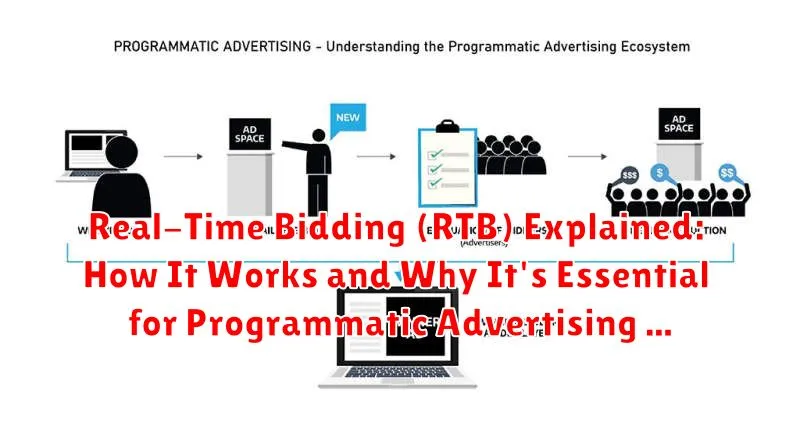In the fast-paced world of digital advertising, staying ahead of the curve requires understanding the latest technologies and methodologies. One such technology that has revolutionized the industry is Real-Time Bidding (RTB). This article will delve into the intricacies of RTB, explaining how it functions as a cornerstone of programmatic advertising. We will explore the underlying mechanics of this auction-based system, where ad impressions are bought and sold in milliseconds, connecting advertisers with the most relevant audience in real time. Discover how RTB is not just a buzzword but a fundamental element for any successful programmatic advertising strategy.
From increased efficiency to improved targeting, the benefits of Real-Time Bidding (RTB) are undeniable. This article aims to provide a comprehensive overview of how RTB operates within the broader ecosystem of programmatic advertising. We will break down the complex processes involved, from impression requests to winning bids, making it accessible to marketers and advertisers of all levels. Understanding RTB is essential for anyone seeking to optimize their ad spend, enhance campaign performance, and achieve greater returns on investment in the competitive landscape of digital advertising. Learn why it’s an indispensable tool for modern marketers globally.
What is Real-Time Bidding (RTB)?
Real-Time Bidding (RTB) is a method of buying and selling online advertising inventory programmatically, in an instantaneous auction.
In essence, it is a real-time marketplace where advertisers bid on individual impressions as they become available. This process allows for highly targeted advertising, as bids are placed based on detailed user data and contextual information.
RTB is a key component of programmatic advertising, enabling advertisers to reach the right audience with the right message at the right time.
Unlike traditional advertising methods, RTB offers a dynamic and efficient way to manage ad campaigns, providing greater control and transparency.
The Key Players in the RTB Ecosystem
The Real-Time Bidding (RTB) ecosystem comprises several key players, each fulfilling a specific role in the automated buying and selling of ad impressions. Understanding these roles is crucial for navigating the programmatic advertising landscape.
- Advertisers: The entities seeking to display their advertisements to target audiences. They define campaign parameters, set bids, and provide ad creatives.
- Publishers: Website owners and content creators who make their ad inventory available for sale through RTB platforms. They provide ad space on their websites.
- Demand-Side Platforms (DSPs): Technology platforms used by advertisers to manage their RTB campaigns. DSPs enable advertisers to bid on ad impressions in real-time and optimize their campaigns based on performance data.
- Supply-Side Platforms (SSPs): Technology platforms used by publishers to manage their ad inventory and make it available for sale through RTB. SSPs connect publishers to multiple ad exchanges and DSPs.
- Ad Exchanges: Digital marketplaces that facilitate the buying and selling of ad impressions between DSPs and SSPs. They conduct auctions in real-time, matching advertisers’ bids with available inventory.
- Data Management Platforms (DMPs): Platforms used to collect, organize, and analyze audience data. DMPs provide valuable insights for targeting and personalization within the RTB ecosystem.
How Does Real-Time Bidding Work? A Step-by-Step Guide
Real-time bidding (RTB) is a sophisticated process that facilitates the automated buying and selling of ad impressions in real time. Here’s a step-by-step breakdown:
- User Visit: A user visits a website or opens an app containing ad space.
- Ad Request: The publisher’s server sends an ad request to an ad exchange, including information about the user and the available ad space.
- Auction Start: The ad exchange broadcasts the ad request to participating demand-side platforms (DSPs).
- Bid Submission: DSPs analyze the user data and, based on pre-set targeting parameters and bidding strategies, submit bids to the ad exchange.
- Auction Execution: The ad exchange conducts an auction to determine the winning bid. This usually involves selecting the highest bidder.
- Ad Serving: The winning ad is served to the user’s browser or app.
- Reporting: Data related to the ad impression is recorded for reporting and optimization purposes.
The entire process, from the user visit to the ad being displayed, occurs in milliseconds.
The Benefits of RTB for Advertisers
Real-Time Bidding (RTB) offers a multitude of advantages for advertisers looking to optimize their digital advertising campaigns. These benefits stem from its automated, data-driven nature.
Enhanced Targeting Capabilities: RTB enables advertisers to target specific demographics, interests, and online behaviors. This granular targeting ensures that ads are shown to the most relevant audience, maximizing the potential for conversions.
Increased Efficiency and ROI: By automating the bidding process, RTB saves time and resources. Furthermore, the ability to optimize campaigns in real-time based on performance data leads to a higher return on investment.
Greater Transparency and Control: RTB provides advertisers with detailed insights into campaign performance, including impressions, clicks, and conversions. This transparency allows for better control over ad spend and campaign optimization.
Access to Premium Inventory: RTB platforms often offer access to premium ad inventory on reputable websites and platforms, expanding reach and improving brand visibility.
Understanding the RTB Auction Process

The Real-Time Bidding (RTB) auction is the engine that drives programmatic advertising. It’s a lightning-fast process where ad impressions are bought and sold in milliseconds.
Here’s a simplified overview:
- User Visit: A user visits a website containing ad space.
- Ad Request: The publisher’s ad server sends a bid request to the ad exchange, containing information about the user and the ad space.
- Bid Submission: Participating advertisers (through their Demand-Side Platforms or DSPs) evaluate the bid request. Those interested submit their bids.
- Auction: The ad exchange runs an auction to determine the winning bid. Generally, this is a second-price auction, meaning the highest bidder wins but pays only the price of the second-highest bid, plus a small increment.
- Ad Serving: The winning ad is served to the user on the website.
This entire process happens in the blink of an eye, enabling highly targeted and efficient advertising.
RTB vs. Traditional Advertising: Key Differences
Real-Time Bidding (RTB) and traditional advertising represent fundamentally different approaches to buying and selling ad space. Understanding their key differences is crucial for advertisers seeking to maximize campaign effectiveness.
One primary distinction lies in the automation and speed of the buying process. RTB leverages programmatic technology to facilitate instantaneous auctions, while traditional advertising often involves manual negotiation and insertion orders.
Furthermore, targeting capabilities differ significantly. RTB offers precise, data-driven targeting based on user behavior and demographics, enabling advertisers to reach highly specific audiences. Traditional advertising typically relies on broader demographic targeting based on media channel characteristics.
Pricing models also vary. RTB employs a bidding system where advertisers compete for impressions in real time, potentially leading to more efficient ad spend. Traditional advertising typically involves fixed pricing based on placement and duration.
Finally, measurement and optimization are enhanced in RTB through real-time data and analytics, allowing for continuous campaign adjustments. Traditional advertising measurement often relies on delayed and less granular data.
The Role of Data in Real-Time Bidding
Data is the lifeblood of Real-Time Bidding (RTB). It empowers advertisers to make informed decisions about which impressions to bid on, ensuring that ads are shown to the most relevant audience.
Without comprehensive and accurate data, RTB campaigns would be significantly less effective. Data allows for precise audience targeting, optimizing bids based on user behavior and demographics.
Here are some key data points used in RTB:
- Demographic Data: Age, gender, location.
- Behavioral Data: Browsing history, purchase history, website interactions.
- Contextual Data: Website content, time of day, device type.
Data Management Platforms (DMPs) play a crucial role in collecting, organizing, and analyzing this data, providing advertisers with actionable insights. These insights are then used to refine targeting strategies and improve campaign performance.
Challenges and Limitations of RTB
While Real-Time Bidding (RTB) offers numerous advantages, it also presents several challenges and limitations that advertisers should be aware of.
Ad Fraud: One significant concern is the potential for ad fraud, including bot traffic and domain spoofing, which can inflate impressions and waste advertising budgets. Robust fraud detection and prevention measures are crucial.
Brand Safety Risks: Ensuring brand safety can be challenging, as ads may appear on inappropriate or undesirable websites. Advertisers must implement strict brand safety filters and monitor ad placements closely.
Complexity: RTB can be complex, requiring a strong understanding of programmatic advertising, data analysis, and bidding strategies. This complexity can be a barrier to entry for some advertisers.
Data Privacy Concerns: The use of user data in RTB raises privacy concerns, particularly with regulations like GDPR and CCPA. Advertisers must comply with these regulations and ensure data privacy is protected.
Lack of Transparency: Sometimes, it can be difficult to gain full transparency into where ads are being placed and how bidding decisions are being made, making it challenging to optimize campaigns effectively.
RTB Best Practices for Campaign Optimization

To maximize the effectiveness of Real-Time Bidding (RTB) campaigns, advertisers should implement specific best practices. These strategies aim to refine targeting, enhance ad relevance, and improve overall campaign performance.
Refine Audience Targeting
Precise targeting is paramount. Leverage first-party and third-party data to define your ideal customer profile. Utilize demographic, behavioral, and contextual data to reach the most receptive audience segments. Continuously monitor and adjust targeting parameters based on performance data.
Optimize Bids Strategically
Employ dynamic bidding strategies to adjust bids in real-time based on auction dynamics and user value. Implement bid shading techniques to avoid overpaying for impressions while maintaining win rates. Regularly analyze win/loss reports to identify opportunities for bid optimization.
A/B Test Ad Creatives
Conduct A/B tests on ad creatives to identify the most engaging and effective messaging. Experiment with different headlines, images, and calls-to-action. Monitor click-through rates (CTR) and conversion rates to determine the winning ad variations.
Monitor Campaign Performance Continuously
Establish key performance indicators (KPIs) and monitor campaign performance regularly. Track metrics such as impressions, clicks, conversions, and cost per acquisition (CPA). Use data insights to identify areas for improvement and optimize campaign settings accordingly.
The Future of Real-Time Bidding: Trends and Innovations
The real-time bidding (RTB) landscape is continuously evolving, driven by technological advancements and shifts in consumer behavior. Several key trends are shaping its future trajectory.
One significant trend is the increasing adoption of artificial intelligence (AI) and machine learning (ML). These technologies are enhancing campaign optimization by providing more granular insights into user behavior and predicting optimal bidding strategies.
Transparency and brand safety are also gaining prominence. Advertisers are demanding greater control over where their ads appear, leading to innovations in verification and monitoring technologies. Furthermore, the rise of connected TV (CTV) and digital out-of-home (DOOH) advertising is expanding the reach of RTB into new channels.
Finally, the industry is moving towards greater privacy compliance, with solutions being developed to navigate evolving regulations while maintaining effective targeting. These innovations promise a more efficient, transparent, and impactful future for RTB.

